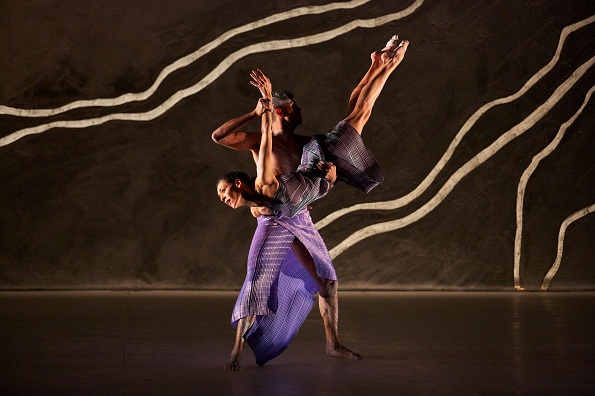Sydney Opera House
August 3 2012
By Renata Ogayar.
Terrain, created by resident choreographer Francis Rings for Bangarra Dance Theatre, truly was an incredible sixty-five minute work that transported me into another time and place of beauty and spirituality.
Centred around Kati Thanda (Lake Eyre), Bangarra in Terrain explored the relationship of Indigenous people and the spiritual connection of the lake and its vast landscape. The cultural semiology in every element was profound, powerful and effortlessly beautiful. The movement sequences, costumes, music, lighting and set design all combined, brought this sculptural masterpiece to life.
Terrain was comprised of nine sections representing the evanescent transformation of the promising, yet harsh place.
The first section, Red Brick, looked past the assembled landscape in order to hear an ancestral calling. Setting the scene, the stage was suddenly lit with powerful white lighting that slowly faded out, accompanied by rumbles of lightning and thunder as the dancers entered the space. The simple, yet highly effective, neutral costumes exposed the powerful bodies of the dancers as they moved in a grounded animalistic manner, seamlessly blending from one form to another.
The mens’ ensemble, Shields, reflected the struggle Indigenous people faced with Land Rights and still face today. The dancers proved their masculinity, holding white shields as they executed powerful movements subsequently driven by their signature focus. This section was particularly mesmerizing with electric beats mixed with an undertone of breath compiled with subtle traditional clap sticks creating suspense.
Contrasting the male ensemble was the ladies ensemble, Spinifex. This piece exhibited the style and femininity of the dancers, inspired by the trees that reside in and around Lake Eyre and the spirit women who are suspended in time. The twig like headdresses and long punctuated skirts, with transitory earthy colours, were most remarkable.
Each section contained detailed choreography so seamless, stunning and entrancing that one could not look away. The movements were full of breath and stylish imagery exploring the use of rise and fall, impulse and instigation whilst remaining connected to the terrain of the stage.
The costumes, designed by Jennifer Irwin, were an art installation in their own right, using the landscape of the piece to aesthetically embrace and complement the choreography, bringing it surrealism and life.
The composition of the music delved into the vastness and spirit of Lake Eyre. Violins and cellos captured the beauty of the land while the subtle breath and voices captured the mystery and the spirit of the mystical place.
Karen Norris’ lighting design incorporated a soft fusion of front lights and heavy back lights that brought an element of sincerity to the work, creating mood and ambience to assist in telling the story.
Finally, the set design brought a dimension to the work, capturing the features of Lake Eyre by creating illusions of density and sparseness through nonfigurative forms, textures and colours.
If there was ever collaboration so stylishly portrayed, it was Bangarra Dance Theatre’s Terrain. If you are not familiar with their work, I highly recommended that you experience one of their performances.
Photo: Deborah Brown and Leonard Mickelo in Bangarra Dance Theatre’s Terrain. Photo by Greg Barrett.

















